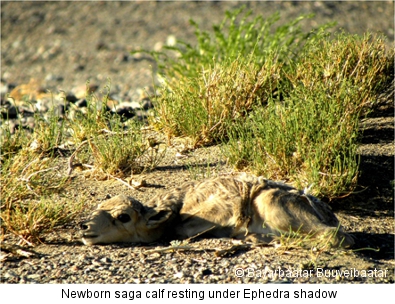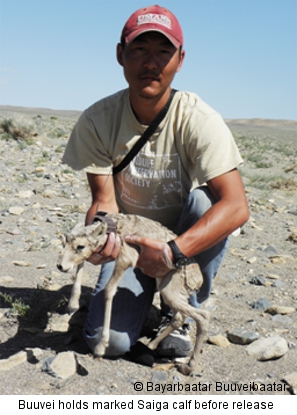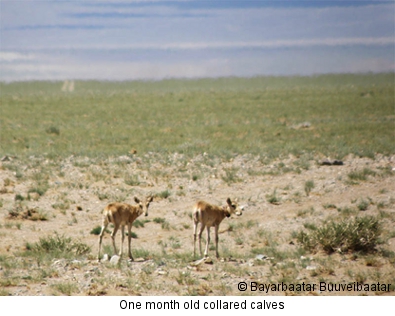EDGE Fellow Bayarbaatar Buuveibaatar, known as Buuvei has sent in his latest update on the progress of his saiga research in Mongolia. The saiga (Saiga tatarica) is one of the world’s fastest animals and poaching has caused a huge population decline. In this blog Buuvei outlines his current research and reports on what he has found.
This project is the continuation of a multi-year research project that aims at understanding the survival and mortality of saiga calves in western Mongolia. This year, the field work has been focused on two major efforts:
1) Capturing and collaring more newborn saiga calves; and
2) Collecting data on their survival and movements.
The capturing effort has been completed within a two week period in June 2010 with the first calf captured on 13 June (2 days later than those captured in 2009).
A total of 36 animals were successfully captured and collared (18 females and 18 males). Surprisingly, only 5.5% were a twin and all the remaining were singletons, which indicates very low twinning rate compared to the data collected over the last two years. This is possibly due to the drought and harsh winter that occurred in the area the previous year. No capture related injury and mortality were to be reported during the collaring period. Some of the calves were too old to be captured; a few attempts were made but failed; the calves did not allow the team to approach close enough to be within net reach. The marked animals did not display hiding behavior and started to follow their mother after about 11 days of capture.
A total of 10 animals (4 males and 6 females) have died due to predation, disease and unknown causes. All of the radio-collars have been recovered from the dead calves. Pre-winter survival rate of marked animals is about 70%. During this time, the majority of deaths were caused by raptor predations.
More than 500 GPS locations have been collected which allowed the team to better understand movement pattern, habitat selection and the connectivity of subpopulations. The team spent a lot of time listening for signals from collared calves from high points using handheld receiver and antenna. When one of the collars gave a strong signal, the team searched for a calf with binocular. The group size of marked animals ranged between 1 and 35 animals during the study period. Two or more marked calves were located in the same herd on four occasions. Movement data and survival data are scheduled to be collected via monitoring as frequently as possible until the collar battery dies off.
If you would like to support the work of Buuvei you can find out more about supporting EDGE Fellows here.



